Our trip to New Mexico has taken us from below sea level (en route from Los Angeles, near Indio, California) into the high desert at elevations up to 7,000 feet. We’ve seen a great deal of fascinating territory, but it will take time to write it all for Under Western Skies.
We escaped the 100-degree temperature in Albuquerque (official elevation 5,312 feet). We went higher.
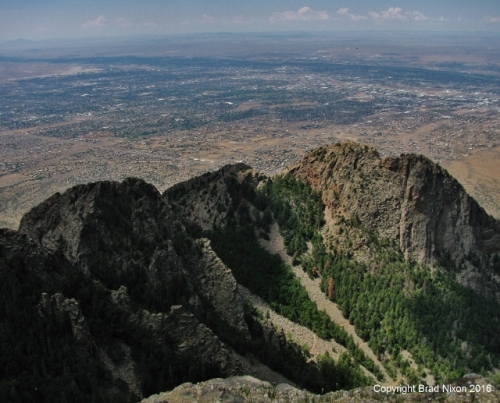
Driving east to the far side of the Sandia Mountains, then north on Route 14, “The Turquoise Trail” (blue circle on map), we turned west up Sandia Crest Highway to Sandia Crest (red oval).
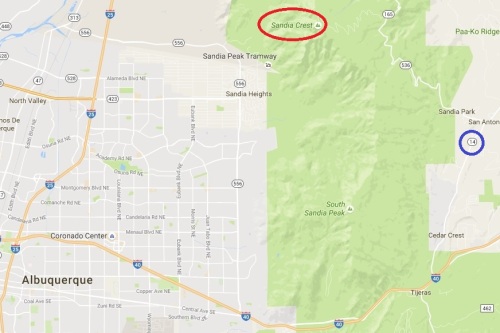
At 10,668 feet, Sandia isn’t a peak that would even be noticed in Colorado, but it rises straight up from the desert below and towers over Albuquerque, which is spread out at its foot across the Rio Grande valley.
The views are spectacular, both west across Albuquerque to distant Mt. Taylor (11,305 feet), and eastward across the plains toward Santa Rosa.
There’s an alternative means of transportation to Sandia Crest: the Sandia Peak Aerial Tram.
The tram departs from the Albuquerque side of the mountain, and the trip takes about 15 minutes. More information at the link above.
The road access reaches a different, slightly higher point than does the tram. Once you’re there, and you approach the edge of the precipice, be careful, especially if you’re traveling with children. There are no guard railings in many places, as in this shot of The Counselor on the trail at the start of our hike.
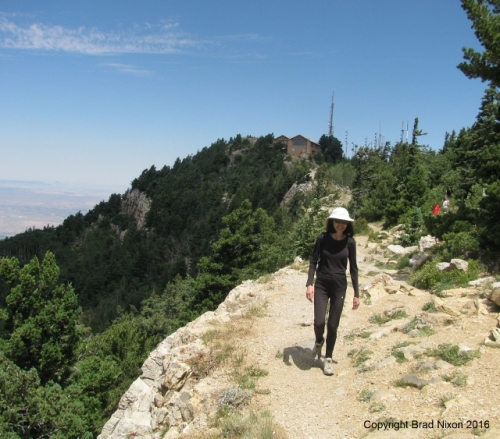
It is a long, long way down a few feet to her right.
Our goal today was more than seeing the tremendous view. We were up for a few hours of hiking in the spruce-fir forest at that altitude as a relief from our previous days of walking under the sun in the sage and chaparral of the desert.
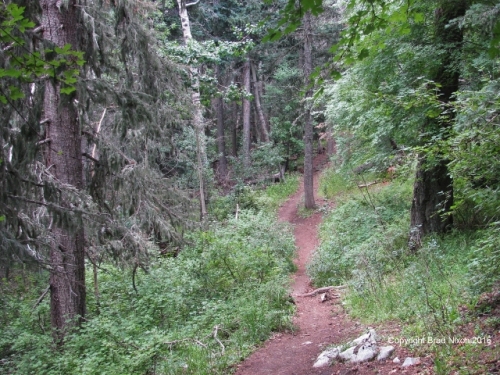
When you hike anywhere, it’s tempting just to walk, walk more, keeping your eyes on that trail ahead and the rocks underfoot, your mind focused on making time, covering ground, or how different it is to walk uphill at 10,000 feet when one is accustomed to life near sea level.
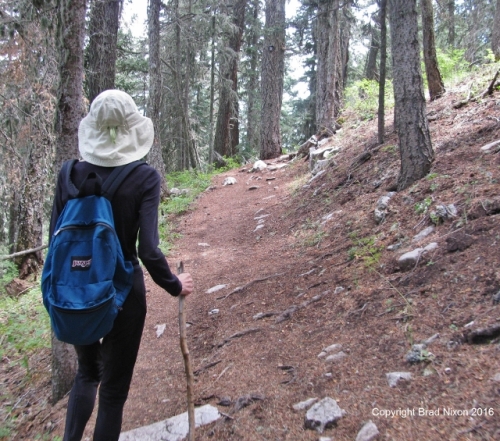
Hiking at its best, though, means using all your senses, especially in a dense pine forest where the air is rich with scent, and the heavy duff on the ground and hundreds of acres of trees dampen sound, making the rapid-fire report of a hairy woodpecker drumming on a trunk stand out amidst the hush. Sometimes the best thing to do is to stop walking, pull your mind away from dwelling on how far you think you’ve been, how much longer to go; simply stand, look, listen, breathe and take it in.
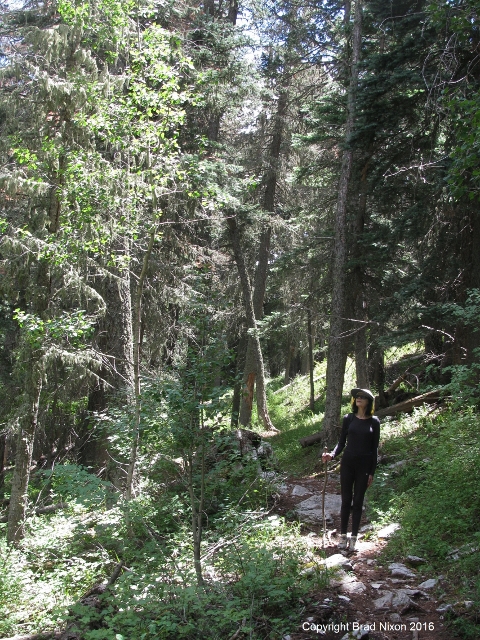
Look up. If you don’t, you’re missing most of the life of trees.
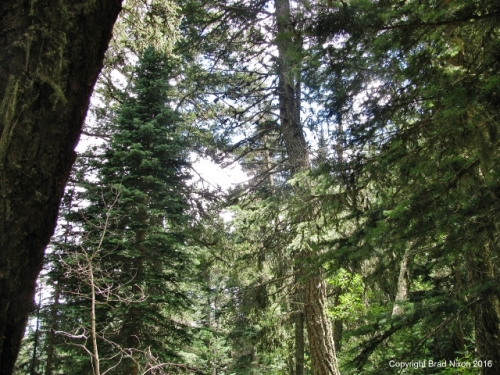
Look left, right, and look down … closely.

If there’s a bright spot of sky off the trail, it probably means something different is there.
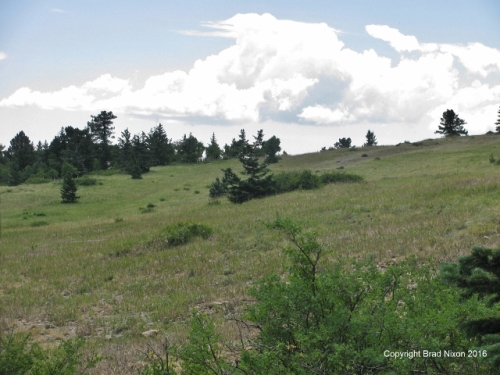
In this case, an alpine meadow: not a common sight in this forest of extremely steep, densely wooded slopes.
That bright spot might also be a gap in the trees caused by the fact that you’re nearly at the edge of the mountain, and Mother Nature has kindly framed the vista for you.
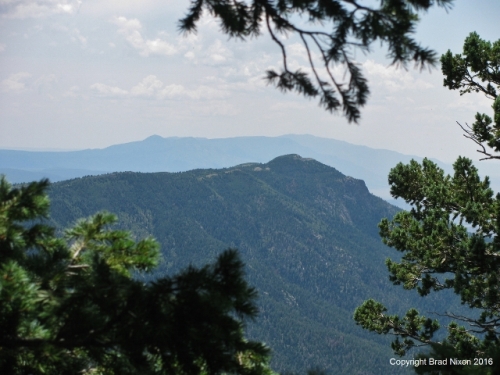
Photography 101, Day 1: “Frame your shot.” Mom N. puts that rule into practice ten million times a day, once you pay attention.
Other compositions abound. Once you start looking, your pace slows, and you’re no longer covering three miles an hour. But the acuity of you observations — not just your photography — improves as your rate of travel decreases.

Don’t forget to look behind you.
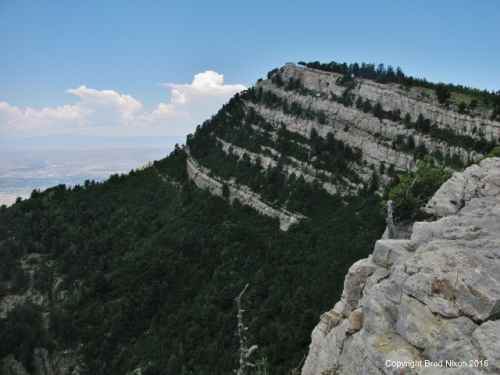
Yes, you were already there, but it looks different now.
Of course, all the time, you’re also looking for wildlife. The Sandias are home to innumerable birds, plus bobcats, porcupines, badgers, mountain lions, ringtails and black bears. We saw none of them, although we saw an Abert’s Squirrel and innumerable Least chipmunks (both too quick to photograph). Also this youngster:

A mule deer (Odocoileus hemionus).
Finally, don’t forget to look at the trees. You are, after all, in a forest, but one of the most overworked cliches in the English language is still true, for all that. Yes, trees are tall to various degrees, have woody trunks, branches, leaves or needles. And those leaves and needles are typically green. Did you ever simply stop and look for a minute, then another minute, considering how many different things that word “green” can signify?
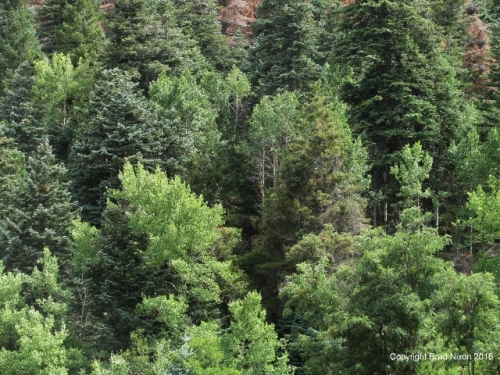
Green: one word, inadequate for the world of meanings it represents. It’s easy to miss the fundamental realities until you look at the world — and reflect on what you see.
Enjoy your next hike, whatever the elevation.
© Brad Nixon 2016, 2017

Great post.
LikeLike
By: ginasjoys on July 29, 2016
at 5:58 am
Thank you, Gina.
LikeLike
By: Brad Nixon on July 29, 2016
at 6:41 am
We love hiking in the Sandia Mountains! You have to come back and do La Luz! It’s from the base to the top.
LikeLiked by 1 person
By: stumblingthroughnature on July 29, 2016
at 4:19 pm
Thanks for reading, liking and commenting. In nearly 30 years of visiting the area, it’s our first time to hike up in the Sandias, believe it or not. We’ve focused on places farther afield, but look forward to La Luz. Thanks for the recommendation. Look for some descriptions of our hikes in Chaco Canyon and Bisti/De-Na-Zin from this week, soon.
LikeLiked by 1 person
By: Brad Nixon on July 29, 2016
at 8:51 pm